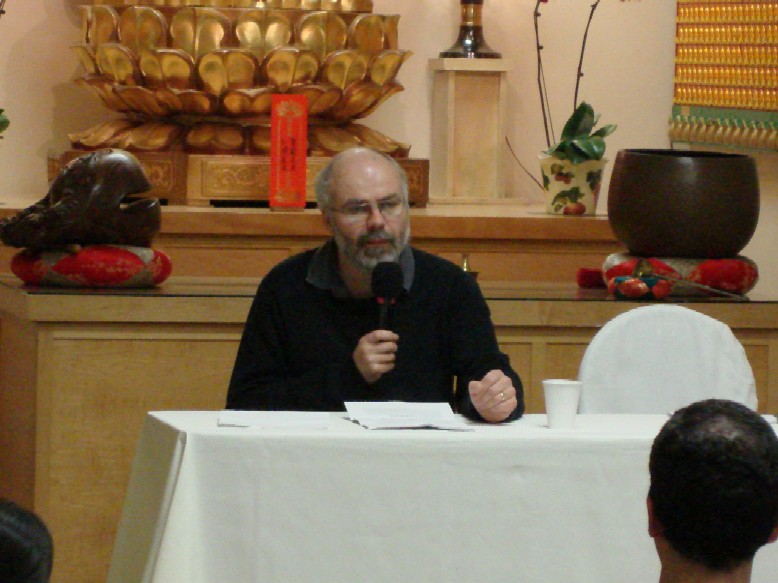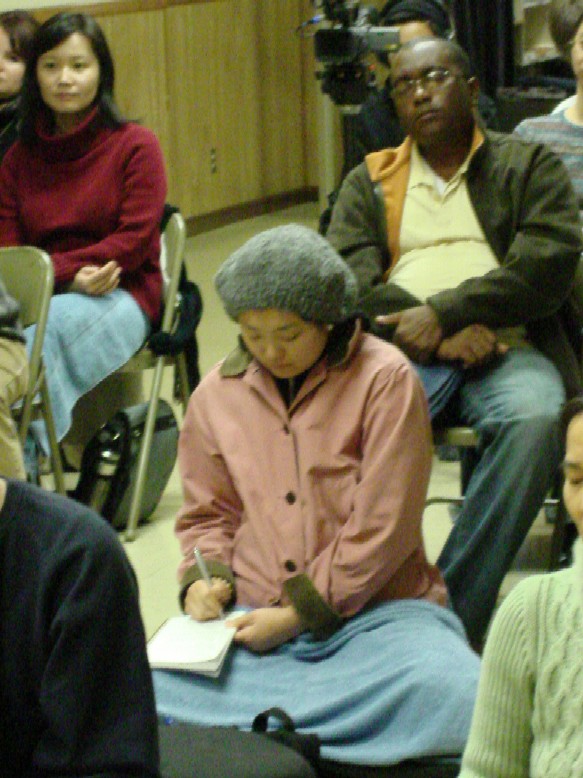| |

Presenting the Dharma within Western Culture: Finding New Expressions whilst Preserving Authenticity
10/24/2008
Report by Chang Jie
 Master Sheng Yen has spent many years
in the West spreading the Buddhadharma to Westerners. Now
it is the responsibility of Shifu’s disciples to continue
his work by first understanding the cultures and
perspectives of Westerners. We’re fortunate to have had the
opportunity to invite one of Shifu's dharma heirs, Dr. Simon
Child, to give a talk at CMC entitled, "Presenting the
Dharma within Western Culture: Finding New Expressions
whilst Preserving Authenticity" on Friday, October 24,
2008.
Master Sheng Yen has spent many years
in the West spreading the Buddhadharma to Westerners. Now
it is the responsibility of Shifu’s disciples to continue
his work by first understanding the cultures and
perspectives of Westerners. We’re fortunate to have had the
opportunity to invite one of Shifu's dharma heirs, Dr. Simon
Child, to give a talk at CMC entitled, "Presenting the
Dharma within Western Culture: Finding New Expressions
whilst Preserving Authenticity" on Friday, October 24,
2008.
Dr. Child began studying meditation
while he was a medical student with Dr. John Crook in
Bristol and Wales in 1981. In 1992, he attended a retreat
with Shifu and in 2000 received dharma transmission. Since
then, he has led retreats in Europe with Dr. Crook.
 During
his lecture, Dr. Child pointed out the need to change the
way the dharma is communicated for the Western audience
because of differences in language and culture. He
emphasized that the dharma itself should not be changed, but
the ways of communicating the dharma, and supported this
view with precedents by the Buddha, past Chan masters, and
Shifu himself. During
his lecture, Dr. Child pointed out the need to change the
way the dharma is communicated for the Western audience
because of differences in language and culture. He
emphasized that the dharma itself should not be changed, but
the ways of communicating the dharma, and supported this
view with precedents by the Buddha, past Chan masters, and
Shifu himself.
According to Dr. Child, teachers have
found different ways of presenting the dharma and methods of
meditation, constantly innovating and experimenting to suit
the individual. In order to convey the dharma in a manner
that is appropriate to the time, culture, and place of the
people, one should try things out, monitor and experiment,
but at the same time, be cautious and preserve
authenticity. This, he said, is a natural process and
essential for the propagation of the dharma.
Another compelling reason for change
that was made is our current place in history; while Chan
was founded in a rural and agrarian environment, the world
is changing and there are huge differences between past and
present, with advances made in commercial and industrial
communication.
Dr. Child argued that Westerners may
need more teachings because they may have more gaps and
ignorance; many Chinese concepts may be confusing because
they do not have the basic foundational concepts. He
described some differences between East and West in terms of
personality and culture, defining culture as comprised of
family, society, employment, finances, mythology, ideas and
values. Some of the major differences include ways of
thinking, educational systems, lifestyles, motivation and
modes of interaction.
 As a response to these differences and
needs, he suggested less emphasis on concepts and practices that may be confusing for
Westerners; he emphasized techniques that are more useful
and relevant for them, such as private interviews,
communication exercises, shorter retreats and the practice
of mindfulness in everyday life. He admitted that he did
not have all the solutions, but that it is necessary to look
at Chan Buddhism again and explore new possibilities for the
Western audience. The lecture was concluded with a question
and answer session.
As a response to these differences and
needs, he suggested less emphasis on concepts and practices that may be confusing for
Westerners; he emphasized techniques that are more useful
and relevant for them, such as private interviews,
communication exercises, shorter retreats and the practice
of mindfulness in everyday life. He admitted that he did
not have all the solutions, but that it is necessary to look
at Chan Buddhism again and explore new possibilities for the
Western audience. The lecture was concluded with a question
and answer session.
|
|